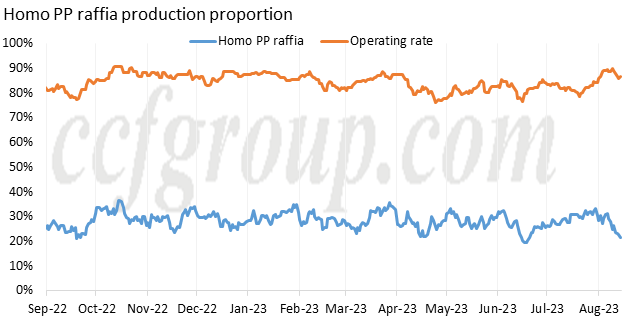Will falling raffia production proportion foster PP market?
It is widely known that polypropylene (PP) can be divided into Homo-polymer PP (homo PP), Copolymer PP (co PP), and Random copolymer PP (ra PP) based on their different molecular structures. Furthermore, PP can be also divided according to its applications, such as raffia, injection, fiber, pipe, and so on. Additionally, it can be further classified based on its melt index. As a result, PP can be considered as a collection of numerous varieties. During the plant operation, different products can be produced by switching production lines, allowing for self-adjustment to avoid the problem of oversupply or shortage of a single variety. However, in reality, petrochemical companies have their own production plans, and there may also be unforeseen circumstances, such as temporary shutdowns, that can lead to significant uncertainties in PP production scheduling.
Recently, the production proportion of homo PP raffia has dropped to a low level, approaching the previous low. As of Aug 14, the production proportion of domestic homo PP raffia is approximately 21.54%, with a daily output of around 24,100 tons.

| China PP production proportion | |||||||||
| HOMO PP raffia | HOMO PP injection | HOMO PP fiber | Co PP | BOPP | CPP | PP pipe | Others | Closed | |
| 11-Aug | 23.54% | 17.36% | 0.09 | 0.19 | 0.06 | 0.03 | 0.04 | 0.07 | 0.12 |
| 12-Aug | 22.96% | 14.43% | 0.10 | 0.17 | 0.07 | 0.02 | 0.04 | 0.09 | 0.13 |
| 13-Aug | 22.83% | 14.83% | 0.10 | 0.17 | 0.06 | 0.02 | 0.05 | 0.09 | 0.14 |
| 14-Aug | 21.54% | 17.79% | 0.08 | 0.17 | 0.04 | 0.05 | 0.03 | 0.10 | 0.13 |
The reasons can be attributed to several factors:
2.PetroChina, on the other hand, has a relatively higher production of homo PP raffia. However, recently, due to factors such as plant shutdowns and transfer of production, the actual production has been limited. For example, PetroChina NorthChina PC, PetroChina Fushun PC and PetroChina Daqing PC have switched their production to BOPP-grade materials, while PetroChina Dagang PC, West Pacific Petrochemical (WEPEC), and PetroChina Hohhot PC have switched to fiber-grade materials. PetroChina Ningxia PC and PetroChina Qingyang PC have switched to produce thin-wall injection molding. Only a few plants, such as PetroChina Liaoyang PC and PetroChina Qinzhou PC, are currently producing homo PP raffia.
3.Other private enterprises also face factors such as plant shutdowns and transfer of production, resulting in similarly low production of homo PP raffia. For example, coal-based chemical companies in the northwest region, which are the main players in coal-based homo PP raffia production, currently have a raffia production capacity utilization rate of only about 32%.
| Region | Plant | Capacity(kta) | O/R | Note |
| Northwest China | Qinghai Yanhu | 160 | 0% | Shutdown |
| Shaanxi Yanchang | 600 | 80% | 1# 300kt/plant producing PPR-MT500B, 2# 300kt/plant producing K7726H | |
| Shaanxi Yanchang ChinaCoal II | 400 | 60% | producing K1870-B | |
| Yan'an Energy & Chemical | 300 | 0% | shut on Jul 1 | |
| Shenhua Ningxia Coal I | 1000 | 100% | 1# 200kt/plant producing 2500HY, 2# 300kt/plant producing 1102K, 3# 200kt/plant producing 1040TE, 2# 300kt/plant producing 1102K | |
| Shenhua Ningxia Coal II | 600 | 100% | 1# 300kt/plant producing PPR-2500HY, 2# 300kt/plant producing 3240NC | |
| Shenhua Baotou | 300 | 100% | producing M700X | |
| Shenhua Yulin | 300 | 0% | shut on Aug 10 | |
| Shenhua Xinjiang | 450 | 100% | producing S1003 | |
| Datang Duolun | 460 | 100% | 1# 230kt/plant producing PPR-L5D98, 2# 230kt/plant producing LC1813 | |
| ChinaCoal Shaanxi Yulin | 300 | 100% | producing L5E89 | |
| ChinaCoal Mengda | 300 | 100% | producing L5E89 | |
| Ningxia Baofeng Energy | 300 | 100% | producing K8003 | |
| Ningxia Baofeng II | 300 | 100% | producing M600E | |
| Pucheng Clean Energy | 400 | 90% | producing HP500N | |
| Zhongtian Hechuang | 700 | 100% | 1# 350kt/plant producing T03, 2# 350kt/plant producing K8003 | |
| Jiutai Energy | 300 | 100% | producing L5E89 |
The short-term impact may be relatively small, as it takes time from produce to market circulation. However, as time goes on, if the proportion of raffia production does not significantly increase, there may be a tight supply of raffia. At the same time, the support from cost side remains, and PP spot price is easy to rise and hard to fall. Under the traditionally peak season in September and October, tight spot supply may further drive up market prices.
- Top keywords
- Cotton Price
- Cotton Futures Price
- Cotton Futures
- CZCE
- PTA Futures Price
- Chemical Fiber
- Polyester Prices
- Wool price
- PTA Futures
- Shengze Silk
- China
- Yarn Price
- price
- China Textile City
- Fibre Price
- Benzene Price
- Cotton
- Index
- Cotton Index
- PTA
- fabric price
- NYMEX
- Top 10
- textile industry
- Spot Cotton
- Cotton Yarn
- Polyester Price
- Futures
- PTA Price
- cotton yarn price

